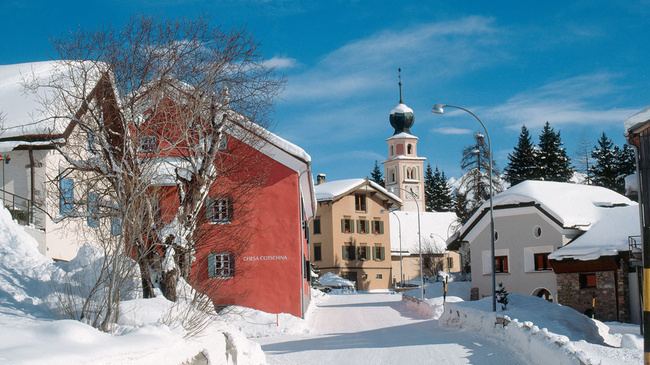Country Switzerland District Maloja Elevation 1,697 m Population 202 (31 Dec 2008) | Canton Graubünden SFOS number 3783 Local time Friday 7:24 PM Postal code 7523 | |
 | ||
Website www.madulain.ch SFSO statistics Weather 4°C, Wind W at 2 km/h, 53% Humidity | ||
Madulain ( [mɐduˈlaɪ̯n] ) is a municipality in the Maloja Region in the Swiss canton of Graubünden.
Contents
Map of 7523 Madulain, Switzerland
History
Madulain is first mentioned around 1137-39 as Madulene.
Geography
Madulain has an area, as of 2006, of 16.4 km2 (6.3 sq mi). Of this area, 33.9% is used for agricultural purposes, while 14.6% is forested. Of the rest of the land, 1.5% is settled (buildings or roads) and the remainder (49.9%) is non-productive (rivers, glaciers or mountains).
Before 2017, the municipality was located in the Oberengadin sub-district of the Maloja district, after 2017 it was part of the Maloja Region. It is the smallest of the eleven municipalities in the district. It is located in the upper Engadin valley between La Punt-Chamues-ch and Zuoz about 15 minutes from St. Moritz on the Inn River. It consists of the Haufendorf village (an irregular, unplanned and quite closely packed village, built around a central square) of Madulain on the Inn at an elevation of 1,684 m (5,525 ft). Until 1943 Madulain was known as Madulein.
Demographics
Madulain has a population (as of 31 December 2015) of 229. As of 2008, 24.8% of the population was made up of foreign nationals. Over the last 10 years the population has grown at a rate of 9.6%.
As of 2000, the gender distribution of the population was 49.2% male and 50.8% female. The age distribution, as of 2000, in Madulain is; 22 children or 12.2% of the population are between 0 and 9 years old. 11 teenagers or 6.1% are 10 to 14, and 8 teenagers or 4.4% are 15 to 19. Of the adult population, 29 people or 16.1% of the population are between 20 and 29 years old. 30 people or 16.7% are 30 to 39, 27 people or 15.0% are 40 to 49, and 22 people or 12.2% are 50 to 59. The senior population distribution is 19 people or 10.6% of the population are between 60 and 69 years old, 10 people or 5.6% are 70 to 79, there are 2 people or 1.1% who are 80 to 89.
In the 2007 federal election the most popular party was the SVP which received 38.2% of the vote. The next three most popular parties were the SP (37%), the FDP (12.2%) and the CVP (10.2%).
In Madulain about 71.2% of the population (between age 25-64) have completed either non-mandatory upper secondary education or additional higher education (either university or a Fachhochschule).
Madulain has an unemployment rate of 1.04%. As of 2005, there were 23 people employed in the primary economic sector and about 7 businesses involved in this sector. 37 people are employed in the secondary sector and there are 3 businesses in this sector. 19 people are employed in the tertiary sector, with 7 businesses in this sector.
The historical population is given in the following table:
Languages
Most of the population (as of 2000) speaks German (53.9%), with Romansh being second most common (22.2%) and Italian being third (17.2%). Currently, a minority of the population speaks the Upper-Engadin Romansh dialect of Puter, though until the early 19th Century the entire village spoke it. Due to increasing trade with the outside world, Romansh usage began to decline. In 1880, 68% named Romansh as their native language in the Swiss census, while in 1900 it was only 55% and by 1910 there were 36 native Romansh speakers and 47 native German speakers. However, during World War II the majority language switched several times. In 1941 the village was 50% Romansh speaking. By 1970 German was again the majority. In 1990, 27.5% named Romansh as their language of best command, with 50.8% naming it as a habitually spoken language, while in 2000 it was the language of best command for 22.2% and a habitually spoken language for 42.8%.
